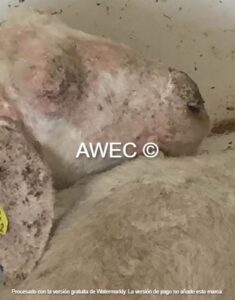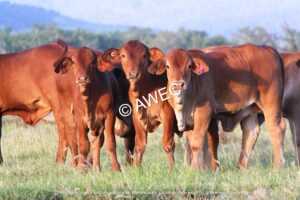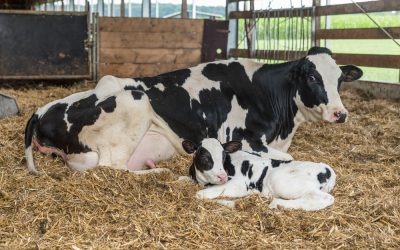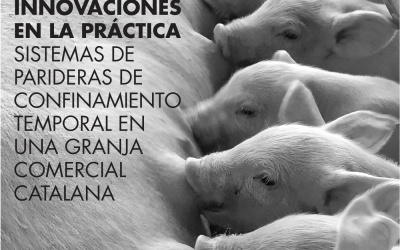Déborah Temple, Eva Mainau, Pol Llonch, Xavier Manteca
April 2024
Endoparasites (internal) and ectoparasites (external) are quite common in cattle, sheep, and goats, and represent a significant economic and welfare burden to the global ruminant livestock industry. Endoparasites and ectoparasites are a problem in both extensive and intensive livestock production. Early detection of subclinical cases of infested animals can allow for a prompt treatment of specific animals to prevent further development of the disease. Embracing a strategy known as targeted selective treatment involves using antiparasitic treatment on specific animals within a herd, guided by factors such as performance, clinical signs, parasite diagnostics and behavioural indicators. This approach not only promotes sustainable practices for enhanced animal welfare but also mitigates the risk of overusing antiparasitic agents, thereby curbing the development of resistant parasites.
Main endoparasites and ectoparasites that affect the welfare of cattle, sheep, and goats:
Endoparasites:
- Nematodes (roundworms)
- Tapeworms
- Lung worms
- Liver Flukes
- Coccidia
- Cryptosporidia
Ectoparasites:
- Mange mites
- Lice
- Ticks
- Myasis flies
- Keds (Louse flies)
- Horn flies & stable flies
- House flies
- Fleas
- Mosquitoes
- Midges
Pain and welfare impacts associated with parasites
The clinical signs and productivity implications associated with endo and ectoparasites are well known. Infested or infected animals are more susceptible to other diseases because parasitism depresses the immune system. In severe or untreated cases, parasites can cause death. Even in absence of clinical signs, reproductive (e.g. pregnancy rate, age at first calving, calving interval, and number of services per conception) and productivity parameters such as wool growth, milk production and weight gain are usually negatively affected. In extensive production systems, the loss of body condition and nutritional deficiencies reduce the survival of animals when food is scarce. Neonatal mortality can increase drastically due to either the infestation of the mother and her low body condition or the direct infestation of the newborn animals.
Clinical signs of parasitism are clearly associated to painful conditions. For example, gastrointestinal parasites can cause inflammation and damage to the stomach and intestinal wall that produce abdominal pain, colic, and discomfort. Clinical signs appear days after the initial infection, when the parasite is already multiplying in the tissue (in the case of gastrointestinal parasites) or when the infestation is producing severe lesions on the skin (in the case of ectoparasites). Pain is not only a welfare problem but also reduces the productive performance of animals.
Clinical signs of gastrointestinal parasitosis
Internal parasites can cause tissue damages to the intestinal wall and other organs such as the liver. These damages result in the interruption of digestive processes and the impairment of the absorption of nutrients. As a result, infected animals may experience symptoms such as diarrhoea, anaemia, reduced appetite, loss of body condition and nutritional deficiencies.
The FAMACHA© anaemia chart in adult sheep, diarrhoea, or dag score (adhesion of loose faeces to the wool around the breech area), body condition score, weight gain and faecal egg count can be useful to identify animals for treatment against parasites. These measures are part of the Five Point Check© protocol developed for the selective treatment of internal parasites in small ruminants on-farm.
Clinical signs of external parasitosis
Ectoparasites include ticks, flies, myiasis, lice, mange, and lice. The skin of the animal is where ectoparasites live, obtain their food and, in the case of permanent ectoparasites, reproduce. Ectoparasites are known to cause skin irritation, skin inflammation, swelling, lesions, altered skin texture, colour and odour, hair loss and wool breakage, depending on the parasite implicated. Lucilia spp. (flystrike or myasis) feed on skin creating large, inflamed lesions with oedemas. Maggots of the flystrike generate inflammatory lesions causing severe irritation and fever. Clinical signs of flystrike include agitation, stamping of the hind legs, vigorous tail shaking, gnawing, and rubbing at the breech or back. The mite Psoroptes ovis (sheep scab mite) punctures the skin to feed on lymph and exudate causing a chronic and exudative dermatitis with intense pruritus. Persistent itching causes discomfort interferes with normal behaviour, rest, and sleep, and increases irritability and frustration. It can lead to wounds and secondary infections. Pruritus is an important animal welfare concern.

Sheep stongly affected by scab mites.
Sickness behaviour and parasitosis
Parasitosis can produce various behavioural changes that, together, constitute what is known as “sickness behaviour.” Sickness behaviour is caused by the release of interleukins and tumour necrosis factor and includes, among other changes, a reduction in food intake and general activity. Sickness behaviour is a well-organized adaptative response to enhance disease resistance and facilitate recovery from disease. It has negative effects on production and appears to be associated with a negative affective state. Animals showing sickness behaviour have more negative or pessimistic-like judgements of a neutral situation and show greater attentional biases towards threatening stimuli. Sickness behaviour is often concomitant with clinical signs.
“The behaviour of an animal may undergo noticeable changes as a response to a challenge such as parasitosis before any apparent clinical signs”.
Behavioural changes in animals infested by endoparasites
Pain associated with parasitosis may be detected through the observation of the behaviour of animals.
In the case of gastrointestinal parasites, it has been suggested that a behavioural response might be connected to the mucosal phase of the infection. Decrease in food intake, decrease in activity, changes in grazing behaviour, abnormal kicking, decrease in standing and lying out frequency, and increase lying and standing time are changes reported after the animal get infected. Dairy cows naturally infected with gastrointestinal parasites show a decrease in eating time, meal duration and total number of bites. Lambs infected with gastrointestinal parasites feed less often, show a reduction in grazing and walking and have altered standing and lying behaviour, most of those changes being detected two weeks post-infestation. Cattle, sheep, and goats infected with gastrointestinal parasites also exhibit less behavioural complexity which refers to the variety and sophistication of behaviours animals exhibit in response to their environment. Real-time monitoring of animal behaviour using sensors and precision livestock farming tools can allow for a continuous and precise measurement of those behavioural changes.
Facial expression and Qualitative Behaviour Assessment
Pain scales based on the facial expressions of sheep have recently been developed and validated. The development of facial expression scales requires the ability to identify the change of specific facial action units when animals are in pain. For example, in bovine, pain compromises five facial action units: ear posture, dilated nostrils, tense and wide eyes, eyebrow tension, jaw tension. These scales can be an especially useful tool to evaluate pain, although additional studies are required to determine their validity in the case of pain caused by parasitosis.
Qualitative Behaviour Assessment may strengthen the monitoring and identification of infested/ infected animals for treatment against parasitosis. Qualitative Behavioural Assessment (QBA) adopts a “whole animal” perspective in evaluating animals by analysing their expressive behaviour and body language. It encompasses the synthesis of information on behaviour, posture, movement, and the surrounding context. Through QBA, observers can discern subtle differences in the behavioural expressions of animals. QBA was employed by observers to detect alterations in behaviour linked to both the extent of parasite infection and the treatment of infection in sheep. Its sensitivity to detect animals with subclinical infestation under field conditions has yet to be studied.

Flies affect grazing behaviour and increase tail movements (AWEC)
Ruminant behaviour in response to ectoparasites
Ectoparasites have, as well, an enormous impact on livestock behaviour, affecting both the frequency of normal behaviour and the occurrence of self-directed behaviour to remove parasites from their skin or around themselves.
Ticks cause dairy cows to step more during milking and this is associated with an increase avoidance to human in an approach test.
Flies reduce grazing time in cattle that try to compensate by grazing more in the evenings and mornings, when flies are not so annoying. Cattle take a pause from grazing to assemble in a defensive formation, typically on elevated terrain where the wind disrupts bothersome flies. They position themselves in a circle, heads turned inward for protection against fly attacks. The more dominant individuals claim the centre, highlighting their priority for the best space. This clustering, while effective against flies, can lead to heat stress in warmer temperatures, hampering their growth. Tail movements of cows grazing in enclosures averaged 12 per min when no flies were released and increased to 36 per min when 100 stable flies were released.
Self-directed behaviours such as scratching, rubbing, and biting can be useful indicators for assessing welfare in animals infested with ectoparasites. Rubbing disturbs lying behaviour and resting time of sheep infested by mange (Psorotes ovis) both during days and nights.
Constant irritation and disturbance of infested animals can also lead to stereotyped oral behaviours such as mouthing, reported in sheep infested by mange.
Preventive measures that have welfare implications
Internal parasites and ectoparasites not only have a negative impact on the welfare of infested animals, but they can prompt preventative or treatment strategies that can also raise significant concerns for animal welfare.
Procedures like tail docking and mulesing, while aiming for certain benefits, if performed without pain killers, cause short- and long-term pain in animals and their supposed protective effect against myiasis is variable. Therefore, it is advisable to evaluate in each case the convenience of carrying out this practice, considering, among other things, whether the farm really suffers from a myiasis problem and, if so, whether the problem can be controlled using other strategies. Pain-free alternatives should first be explored. When the above-mentioned mutilations are performed, they should be done properly, hygienically and using pain killers with an adequate protocol.
The administration procedure of antiparasitic treatment itself may in some cases raise welfare concerns as well. Deeping or dosing of animals should be carried with low stress handling techniques, proper drug administration techniques and well-designed facilities.
A bidirectional relationship
The relationship between parasitic diseases and animal welfare is bidirectional, that is, in the same way that parasitic diseases reduce welfare, a lack of welfare increases the risk of animals suffering from serious parasitosis. This is mainly because many welfare problems are associated with a chronic stress response. In turn, chronic stress has an immunosuppressive effect, which increases the susceptibility of animals to both infectious and parasitic diseases. Furthermore, feeding-related welfare problems that either reduce the body condition of animals or are associated with a protein deficiency also increase susceptibility to parasitic diseases.
Take home message
Given the relationship between parasitic diseases and animal welfare, regularly assessing animal welfare and behaviour could help to identify and prevent parasitosis in ruminants. This, in turn, would allow a more rational use of antiparasitic drugs: preventive management strategies that improve the welfare of animals will increase their resistance to parasitic diseases. Ultimately, the integration of animal welfare into parasitic disease prevention programs could be a tool to reduce the problem of resistance of some parasites to antiparasitic drugs.




